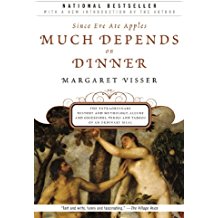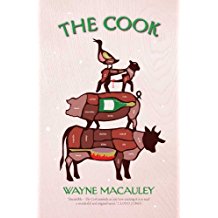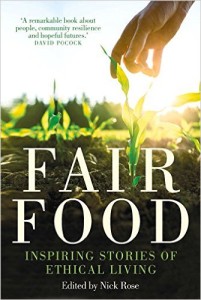Book Review: “Much Depends on Dinner” by Margaret Visser

This book starts with a quote from Byron’s Don Juan: “Since Eve ate apples, much depends on dinner”. Visser uses the conceit of an ordinary American dinner to look at the historical, cultural, agricultural, processing and marketing strands of it. In other words it is an anthropology of a meal which consists of: corn on the cob with butter and salt, chicken, rice, lettuce salad with a dressing of olive oil and lemon juice, and ice cream. The very stuff we take for granted.
It was written in 1986 well before Michael Pollan, Mark Kurlansky and Barbara Kingsolver were published, and covered similar subject matter.
Visser was curious about all things epicurean:
A meal is an artistic social construct, ordering the foodstuffs which comprise it into a complex dramatic whole, as a play organises actions and words into component parts such as acts, scenes, speeches, dialogues, entrances and exits, all in the sequences designed form them. However humble it may be, a meal has a definite plot, the intention of which is to intrigue, stimulate and satisfy.
To give you an idea of her approach, the following is a summary of the chapter on chicken.
She discusses the different traditions of carving a roasted bird, and how it would have been dealt with in various countries. Also, the festive and ceremonial aspects of roast chicken which continued for centuries.
Traditionally North Americans did not like their chicken mixed with rice, as in a paella or biriani. They generally liked the elements of a meal kept separate, ie. the traditional ‘meat and three veg’. This came from the British who wanted good food undisguised, and the Puritan tradition in the US continued with this aesthetic.
The fried chicken of the southern states has become ubiquitous along with the increase of finger foods with dipping sauces. This meant wholesalers are now selling more chicken pieces to the burgeoning fast food outlets, and not so much the whole bird. Visser also mentions the giant industrial agribusinesses, which control all aspects of this industry. Fast food chains want uniformity, so that customers can buy food which is bland, recognisable, with no ‘weird’ flavours. Also they want it fast, and never mind the environmental damage of all the packaging.
She discusses the origins of the first chicken, gallus gallus, in south east Asia, and the gradual uptake of eating chicken meat and eggs, which are symbols of fertility. People in the Indus Valley had domesticated this fowl by 2000 BC. This domestication spread far and wide, and wound up in Rome. Cockfighting started and continues today in places like Indonesia.
Cocks are related to the Greek god Hermes. They ‘rule the roost’ and are meant to protect their womenfolk from other cocks. She talks about the ‘pecking order’, and it’s a sorry state if a rooster is ‘hen-pecked’.
Modern methods of keeping and killing poultry are described, including the use of antibiotics, factory farming and ubiquity of eating chicken throughout the world. There was an American fad where supermarkets claimed that customers only wanted pre-butchered and boned chicken.
This was in the Sixties, when convenience and processed foods were being stocked at supermarkets, with not always healthy or desirable results. These practices continue today.

 This book is a compilation of chapters written by people involved in local food production in one way or another. Nick Rose asked them to write a chapter about how their interest in the food production business, and how that came about.
This book is a compilation of chapters written by people involved in local food production in one way or another. Nick Rose asked them to write a chapter about how their interest in the food production business, and how that came about.